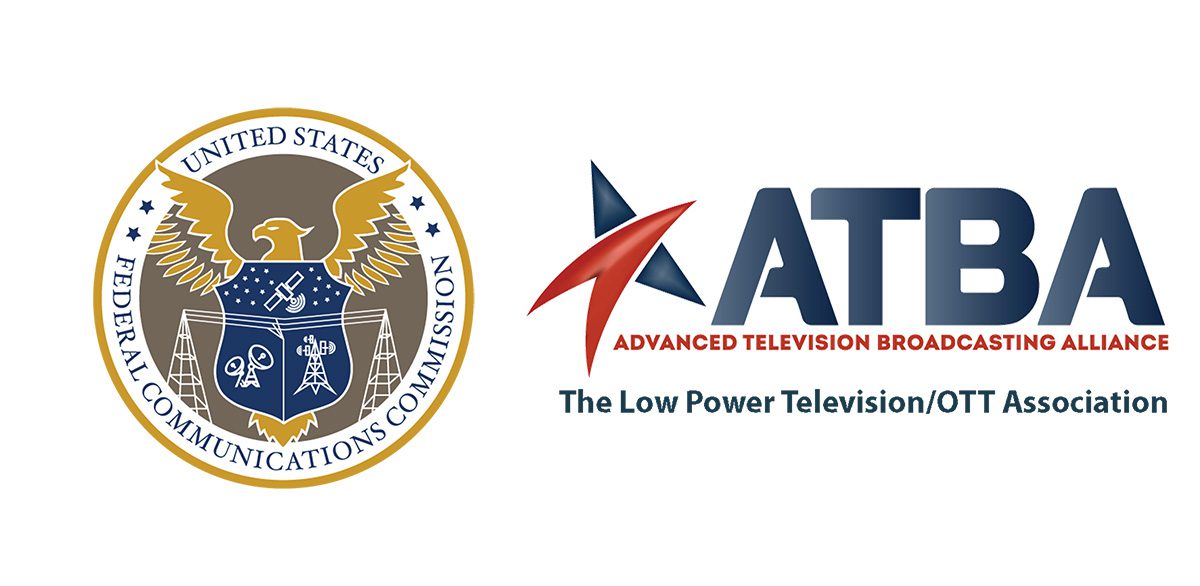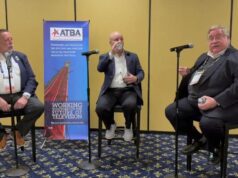COMMENTS OF ADVANCED TELEVISION BROADCASTING ALLIANCE
The Advanced Television Broadcasting Alliance (“ATBA”), the trade association for the low power television (“LPTV”) and over-the-top (“OTT”) industries, submits these comments in response to the Federal Communications Commission (“FCC” or “Commission”)’s Fifth Notice of Proposed Rulemaking in the above-captioned proceeding.1 The ATBA strongly supports measures that provide LPTV stations with the flexibility to offer innovative, high-quality service to the public. The proposal in the Fifth NPRM to permit the operation of analog FM radio services by channel 6 digital LPTV stations (“FM6 operations”) would do just that.
FM6 operations represent an efficient use of broadcast spectrum to supplement the over-the-air video and other ancillary or supplementary services an LPTV broadcaster may offer. FM6 stations have a demonstrated history of providing diverse programming to largely underserved communities. Moreover, the Commission has ample authority to authorize FM6 operations on an ancillary or supplementary basis (to the extent they are not already authorized under the Commission’s rules).
As the FCC revisits the relationship between operations on TV channel 6 and nearby FM frequencies, it must take care not to take any action that would further limit LPTV operations. The low power television community, which includes both broadcasters and their viewers/listeners, has had to navigate the contraction in available broadcast television spectrum in recent years. Indeed, in many markets, LPTV stations have had to move to channel 6 as a last resort when no UHF spectrum was available. The channel 6 protection rules have provided certainty and stability since their inception. Should the Commission revisit those rules, it must take care to do so in a manner that would not impose further harm on the low power television community.
I. LPTV LICENSEES SHOULD HAVE BROAD DISCRETION TO USE THEIR SPECTRUM IN THE PUBLIC INTEREST, INCLUDING FOR FM6 OPERATIONS
Since its inception, the LPTV service has served as an outlet for diverse voices and a sandbox for innovation in the broadcast industry. The LPTV service has flourished due in large part to a regulatory regime that has provided operators with the flexibility to experiment, whether with new formats or with new technologies. As the broadcast industry continues to adapt to changes in technology, LPTV stations are well positioned to help lead the way through continued innovation.
FM6 operations provide a strong example of how LPTV stations can harness flexible regulatory policies to better serve the public. The Commission should permit LPTV licensees the flexibility they need to be able to offer innovative, high-quality services in the public interest, and FM6 operations are no exception. In the interest of promoting the flexible use of LPTV spectrum, the Commission should allow channel 6 LPTV stations to broadcast an aural signal on 87.75 FM moving forward. Moreover, the Commission should not limit FM6 operations to a handful of grandfathered stations that were fortunate enough to have the resources to obtain a special temporary authority to operate as an FM6 station.
A. Allowing LPTV Stations to Provide Programming in Multiple Formats Serves the Public Interest
The NPRM asks “whether it is in the public interest to allow continued FM6 operations in the digital LPTV world, and whether it should be authorized to continue in any capacity.”3 The answer to each of these questions is a resounding yes.
As the Commission noted, the record is replete with examples of how channel 6 LPTV stations that broadcast an aural signal on 87.7 FM (“FM6 stations”) deliver niche audio programming that is responsive to listeners’ needs and that fills voids in the markets they serve.4 By and large, FM6 stations produce their programming locally and target it to populations that are traditionally underserved, including immigrant communities, racial and ethnic minority communities, and older Americans. Using unique program formats, FM6 stations provide their audiences with vital information and specialized entertainment that caters to listeners’ specific interests, all of which is unavailable elsewhere on the dial.
The value of FM6 operations to listeners is also well documented. Millions of listeners across the country have tuned in to 87.7 FM over the years for Spanish-language religious and sports programming; programming intended to support immigrant communities acclimating to their new homes; music programming designed for baby-boomers; Italian, Polish, and Bosnian foreign language programming; programming geared toward African Americans of Caribbean descent; and everything in between.5 The Commission recognized the benefit these stations provide when it granted special temporary authority to 13 such stations to continue their operations following the digital transition.6
The availability of ATSC 3.0 only enhances the public interest of FM6 operations. In the analog days, a broadcaster could not transmit a separate audio stream for its video programming and for radio reception. As a result, parties opposed to FM6 (or Franken FM, as they pejoratively called it) claimed that tailoring the programming to audio listeners was an inefficient use of spectrum. Today, the opposite is true. An ATSC 3.0 signal can be configured with greater bandwidth than an ATSC 1.0 signal and still leave enough room for an analog audio carrier within the same 6 MHz channel. Therefore, FM6 stations have the capability to broadcast multiple streams of synchronized digital audio and video, additional data services, and an 87.7 FM signal – serving the public in many different ways through the same broadcast channel.
To be clear, FM6 operations are just one of many ways that LPTV broadcasters can use their spectrum to serve the public interest. The FCC should adopt flexible regulatory approaches, including facilitating FM6 operations, that allow broadcasters to determine how best to use their spectrum to serve their local communities, and the amount of flexibility afforded a station should not depend on whether it was providing FM6 service at some arbitrary point in time. FM6 operations serve the public interest regardless of whether the station is new to channel 6 or has been providing service for many years.
B. Authorizing FM6 Operations as Ancillary or Supplementary Services Complies with the Communications Act and the Commission’s Rules
In the NPRM, the Commission asks whether “existing FM6 operations [should] be authorized as ‘ancillary or supplementary’ services” and “whether FM6 operations comply with the ancillary or supplementary provisions in the Act and the Commission’s rules . . . .”7 Both the Communications Act of 1934 as amended (the “Act”) and the Commission’s rules allow FM6 operations on an ancillary or supplementary basis and the FCC should expressly authorize such services.
FM6 operations are fully consistent with Section 336 of the Act, which provides that the FCC may allow a licensee or permittee “to offer ancillary or supplementary services if the use of a designated frequency for such services is consistent with the technology or method designated by the Commission for the provision of advanced television services . . . .”8 The Commission has interpreted this provision broadly, explaining that the only restriction on ancillary or supplementary services is that they must “not derogate any advanced television services (i.e., free over-the-air broadcast service) that the Commission may require.”9 Therefore, an LPTV station’s use of an analog audio carrier that does not degrade the station’s primary video signal satisfies Section 336(b)(1)’s requirement for ancillary or supplementary services.
Similarly, FM6 operations fall within the scope of the Commission’s rules for ancillary or supplementary services. Under Section 73.624 of the Commission’s rules, a DTV station may use its spectrum to “offer services of any nature, consistent with the public interest, convenience, and necessity, on an ancillary or supplementary basis[,]” provided that the station “transmit[s] at least one over-the-air video program signal at no direct charge to viewers on the DTV channel.”10 Section 73.624(c) specifies that “[t]he kinds of services that may be provided include . . . aural messages” and “audio signals . . . that do not derogate DTV broadcast stations’ obligations” to transmit their video signals, and that these services “may be provided on a broadcast, point-to-point or point-to-multipoint basis . . . .”11 In turn, Section 74.790(i) of the Commission’s rules provides that, upon transmitting an over-the-air video program signal at no direct charge to viewers, a digital LPTV station may also “offer services of any nature, consistent with the public interest, convenience, and necessity, on an ancillary or supplementary basis” in accordance with Section 73.624(c).12
Although FM6 stations transmit their audio programming through a separate analog audio carrier, the fact that Section 73.624(c) permits stations to provide ancillary or supplementary services on a “point-to-point or point-to-multipoint basis”—which would similarly necessitate the use of a separate carrier—indicates that the analog nature of FM6 stations’ audio signals should not prevent FM6 operations from being permissible under the Commission’s rules. Therefore, just as Section 73.624(c) explicitly allows the provision of “aural messages” and “audio signals” on an ancillary or supplemental basis, the Commission may authorize FM6 operations as ancillary or supplemental services under its rules.
II. THE FCC SHOULD ENSURE THAT ANY CHANGES TO THE TV6 INTERFERENCE PROTECTIONS DO NOT RESULT IN FURTHER DISPLACMENT OF OR OTHER ADVERSE EFFECTS ON LPTV STATIONS.
The ATBA supports the removal of restrictions that no longer serve a valid purpose; however, the FCC should not remove any Channel 6 restrictions without carefully analyzing cross-service interference issues and, in particular, their effect on LPTV stations. In the Fifth NPRM, the Commission seeks comment on “whether to completely eliminate the television channel 6 (TV6) distance separation (interference protection) rules for Low Power FM radio (LPFM), NCE FM radio, Class D FM radio (10 watt), and FM translator stations operating on reserved band FM channels 201-220, or to alternatively revise and update them for a post-digital transition world.”13 The agency asks a number of questions about this proposal, including whether the interference protections continue to be necessary and the potential for TV6-FM cross-service interference.
As an initial matter, the FCC must approach this question from the standpoint that Channel 6 is expressly authorized for both full power and low power television service in the table of frequency allocations.14 The Commission has previously recognized that “[b]ecause of their proximity to Channel 6 TV’s frequency band, some educational stations have the potential of causing interference to Channel 6 reception, a point taken into account in authorizing these FM stations.”15 Indeed, the low power FM rules include specific protection criteria for full power and low power Channel 6 television stations while the rules for noncommercial educational FM stations include one set of protections for all Channel 6 television stations.16
Before the Commission eliminates any of the existing Channel 6 protections, it must be certain that such elimination would not cause interference to any full power or low power Channel 6 stations. In conducting this analysis, the agency should consider the possibility of interference between existing and future FM stations on channels 201-220 and existing or future Channel 6 TV stations. Additionally, the FCC must not only consider the effect on an ATSC 1.0 and ATSC 3.0 video signal, but also on any authorized ancillary or supplementary services offered by Channel 6 TV stations (including FM6 operations).
It is particularly important that the FCC adopt a cautious approach with regard to interference to Channel 6 LPTV stations given the dearth of available spectrum in many markets. Elimination or modification of the Channel 6 interference protections threatens to prioritize the expansion of FM stations at the expense of existing TV stations. But disrupting an existing service upon which consumers depend to facilitate a new service is not in the public interest. Indeed, the Commission has already subjected LPTV stations and their viewers to the contraction of the TV band from 68 channels to 51 channels to the current 36 channels. It would not serve the public interest to take any action that could result in further displacement of existing television stations or the FM6 operations that the agency is proposing to authorize in this proceeding.
III. CONCLUSION
LPTV stations are at the forefront of the transition of television broadcasting in an era of rapid change in the video distribution industry. The Commission should provide LPTV stations with the flexibility to provide innovative, high-quality services and to maximize their service to the public through, among other things, expressly authorizing LPTV stations to conduct FM6 operations. Meanwhile, the Commission must take care when modifying or eliminating Channel 6 protections to ensure that such modifications will not impact or restrict LPTV operations.
Respectfully submitted,
ADVANCED TELEVISION BROADCASTING ALLIANCE
Lee Miller
Executive Director
1511 S. Chestnut St.
Lufkin, TX 75901
[email protected]
(877) 214-4277
July 18, 2022
1 See Amendment of Parts 73 and 74 of the Commission’s Rules to Establish Rules for Digital Low Power Television and Television Translator Stations, Fifth Notice of Proposed Rulemaking, FCC 22-40 (rel. Jun. 7. 2022) (“Fifth NPRM”).
2 See id. ¶ 1.
3 Fifth NPRM ¶ 18.
4 Id.
5 See, e.g., Comments of Preserve Community Programming Coalition at 1, 5-6, MB Dkt. No. 03-185 (Jan. 22, 2020).
6 See, e.g., LMS File No. 0000147729 (granting STA for KBKF-LD, San Jose, California).
7 Fifth NPRM ¶¶ 17, 22.
8 47 U.S.C. § 336(b)(1).
9 Promoting Broadcast Internet Innovation through ATSC 3.0, Declaratory Ruling and Notice of Proposed Rulemaking, 35 FCC Rcd 5916 ¶ 6 (2020).
10 47 C.F.R. § 73.624(b), (c).
11 47 C.F.R. § 73.624(c).
12 Id. § 74.790(i). Section 74.790(i) also requires that digital LPTV stations offer these services in accordance with Section 73.624(g), which requires licensees to “remit a fee of 5 percent of the gross revenues derived from all [feeable] ancillary and supplementary services . . . .” Id. § 73.624(g).
13 Fifth NPRM ¶ 50.
14 47 C.F.R. § 2.106.
15 Changes in the Rules Relating to Noncommercial Educations FM Broadcast Stations, Second Report and Order, 69 FCC 2d 240, 245 n. 9 (1978)
16 See 47 C.F.R. §§ 73.825 (LPFM protections), 73.525 (NCE-FM protections), 75.1205 (NCE-FM translator protections).














